As the British offensive under Yprom drowned in mud
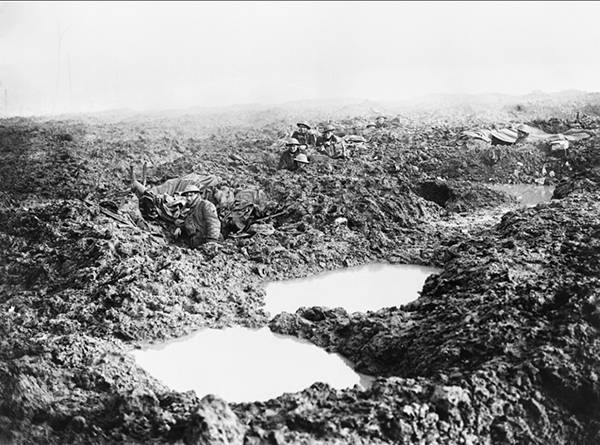
100 years ago, in November 1917, the Battle of Paschendale ended (the third battle of Ypres). The large-scale offensive operation of the Allied forces with the aim of seizing the coast of Belgium in order to deprive the German submarines of the supply bases did not lead to success.
Battle of Pashendeyle has become one of the bloodiest battles of the First World War - the two sides of 4 months (the battle went in July) lost in killed, wounded and captured more than 850 thousand people.. In this protracted battle it was one of the most difficult in the war, a symbol of a soldier suffering in appalling conditions - the ground was low-lying, swampy, almost all the time there were torrential rains, turns the battlefield under constant shelling in impassable quagmire. The troops on both sides actually "drowned in the mud", suffered huge losses. And all these terrible burdens were in vain - the Allies advanced only a few kilometers.
The overall situation on the Western Front
The campaign plan for the 1917 year was adopted by the Entente countries at the end of the 1916 year, at a conference in Chantilly. This plan assumed the simultaneous advance of the Allied armies on the three main fronts (French, Russian and Italian) and the final defeat of the forces of the Central Powers.
The new commander in chief of the French army, General Robert Nivelle, insisted on a decisive offensive on the Western (French) front. According to his plan, the decisive blows of the Anglo-French troops were to lead to the breakthrough of the German front and the defeat of the enemy. The main burden in the upcoming attack fell on the French troops. However, Nivelle’s spring offensive failed ("Nivel Meat Grinder"), it was not possible to break through the enemy front, the Allies suffered heavy losses. Nivel himself for the failure of the operation was removed from his post as commander in chief of the French army.
After the failure of Nivelle Offensive umyvshayasya blood of the French army for a while I was not prepared to spend any decisive action, while London has finally approved the plan of the British commander Douglas Haig on the offensive in Flanders. British commanders hoped to break through the German front, take the ridge Pashendeyl seize Belgian ports and destroy the base of German submarines, dealing a decisive blow to the unrestricted submarine warfare strategies, which caused great damage to the UK.
Ypres District
The front line in the Ypres region stabilized at the end of the 1914 of the year, after the Battle of Flanders. Ypres remained in the hands of the Allies, and German troops camped on the ridge to the south of the city, on the east ridge was less, and from the north German units were located in the plain. The German command understood that an attack by the enemy in Flanders was very likely. Therefore, strong defensive positions were created here. The number of German defense lines reached five. Positions were well fortified. The peculiarity of the Ypres region was the swamps. The terrain lay below sea level. The swamps stretched for many tens of kilometers and covered most of the Pashendale area. Artillery fire further worsened the situation, creating a "lunar landscape."
7 1917 June, the British army began an offensive in the area of the Belgian village MESEN (the French name - Messina) on the Franco-Belgian border near the coast. Of fundamental strategic importance, it did not have, but entered into history like the battle of Messina. She became famous thanks to the man-made explosion that was the most powerful in the course of this war.
The main task of the British in the course of this offensive was to seize the so-called Messinsky Ridge, a chain of hills on which the well-fortified positions of the enemy were located, deeply crashing into British defense. Because of this, the German troops were kept under the control of the British trenches and advanced artillery battery that allows you to fire on them, not only from the flanks, but in some places, and in the British rear. According to the plan developed by General Haig, commander of British forces in Europe, this 15-kilometer protrusion in the German defense was to be cut off. This was especially important in the run-up to the offensive prepared by the British command in the area of the city of Ypres. The Messinsky Range could have become a big threat to the big British offensive in the Pashendale region, because from this point of view the Germans could launch a counterstrike.
Engineering preparation for the capture of Mecena was carried out by the 2 of the English army under the command of General Plumer since 1916, and was activated from the middle of winter. The main novelty was laying for the German positions of underground galleries-digging. In total, 24 dug huge tunnels with a total length of 8 thousands of meters. As already noted above, the terrain was swampy, so they dug deep, under the second level of groundwater in the blue clay formation. The excavated soil was camouflaged so that German reconnaissance aircraft would not notice it. The Germans still uncovered the British plan, but were able to detect only two tunnels, having made a mistake in the scale of the undermining made by the enemy. German sappers searched for them at a depth of no more than 20 meters, while the British laid most of the tunnels at depths greater than 25 meters.
When the preparatory work was completed, the British laid 19 large mines under the German position with a total charge mass of more than 600 tons of explosives. Interestingly, shortly before the start of the operation, the plan almost fell through. General Plumer was informed that German sappers, carrying out their mine action, were only half a meter from one of the already mined tunnels, but he showed composure and did not detonate the ammunition before the target date, which allowed the British to deliver an unexpected blow of enormous force to the enemy. In addition, the British concentrated powerful artillery in the area of operation. On a plot of just 3 kilometers, 718 cannons and howitzers, 192 trench mortars and 198 machine guns were deployed. About 300 airplanes and more than 80 were also used tanks.
7 June in 3 hours 10 minutes of the morning the British blew up mines. The explosions were terrible power. The first line of trenches of the German troops was completely destroyed, the second part. Only when the explosion killed more than 10 thousand. German soldiers and officers who had survived were so shocked and demoralized that they could not offer resistance to rush to attack the British. He they fled or surrendered. Already by 7 o'clock in the morning the whole Messinsky Ridge was occupied by British troops. At 3 one o'clock in the afternoon, tanks and reserve units were thrown into the breakthrough, which captured even more 7 thousand German soldiers and officers. By the evening, having collected reserves, the Germans went to the counterattack, but were discarded, but the British after that were able to advance another 2 kilometer. The battle lasted until 14 June, but without such large-scale successes. The Germans came to their senses and stabilized the front line. In the wake of the battle, the British won a convincing and unconditional victory, completely solving the task and aligning the front line on the eve of the strategic offensive operation.
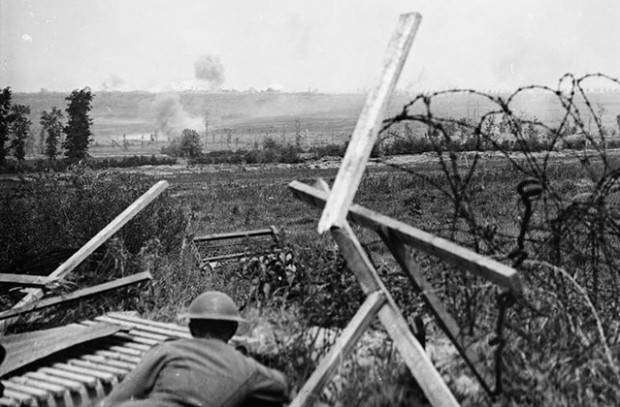
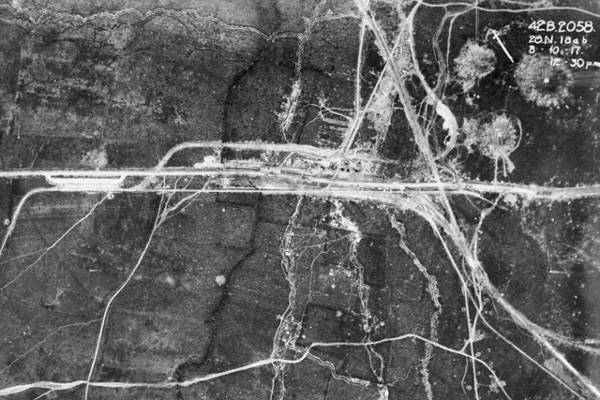
Three craters (in the upper right corner of the frame) from mines that exploded on the German positions 7 June 1917
The forces of the parties
According to the plan of operation, the main blow to the enemy’s positions was delivered in the direction of Ypres, Pelkapel, Pashendale, the breakthrough area was about 4 km. The main striking role in this breakthrough was played by the 5-I British Army, which had four corps (9 divisions). 5-2 Army support-I British army, which had three corps (5 divisions), as well as 1-French Army as a part of the housing of the two divisions. Allied troops in the area of the alleged breakthrough were well equipped with weapons technology. Only British troops had 3594 guns in them, of which 1327 was heavy. The British had 548 planes (of which 230 fighters), the French had 200 planes (of which 100 fighters). The most important role in the upcoming operation was assigned to tanks, in the allied forces there were 216 armored vehicles. They were distributed in small groups between the attacking divisions of the 5 Army.
In this sector of the front, the 4 th German army occupied the defense. German troops were much inferior to the troops of the Entente in this sector of the front. Against 5-Second British Army, the German command had 13 divisions (5 on the front, 4 line in the near reserve and 4 in the strategic reserve). Against the French corps, the Germans deployed 2 divisions (one was in reserve). German troops had 1556 guns of all kinds, of which 737 guns were concentrated against the 5 British Army. The German Air Force numbered around 600 aircraft.
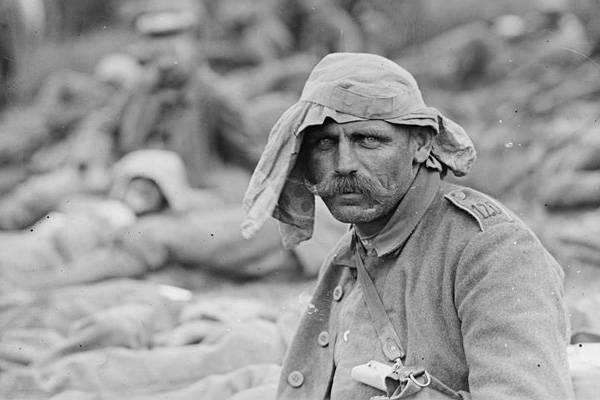
Captured German soldiers
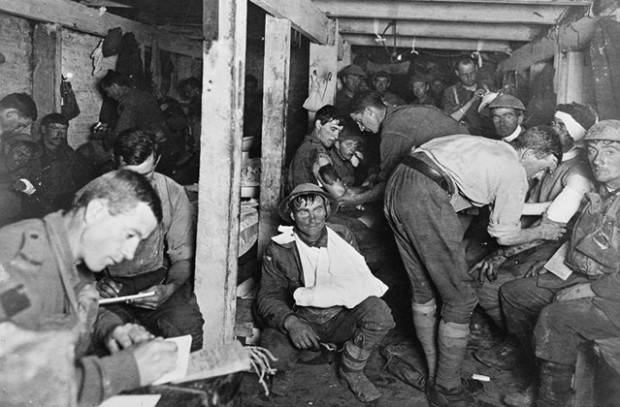
Dressing point of the Australian troops during the third broken at Ypres
The beginning of the battle
July 11 1917, the British launched a massive artillery shelling and bombardment of German positions in the Ieper area in the south-west of Belgium in preparation for a new major offensive. The Germans did not suffer any special losses during the artillery preparation, as they took the troops from the forward positions to the shelter of the rear in time.
13 July Germans avenged the June defeat - began a chemical attack. They for the first time applied a new deadly poison-blistering substance. Initially, it had the code designation “yellow cross”, and later it became known due to the characteristic smell as “mustard gas” and went down in history after the name of the city of Ypres - like mustard gas. Mustard affected the lungs, nasopharynx and eyes of soldiers, caused terrible ulcers when it hit the skin. There was no antidote from him. It differed from other gases in that the gas mask did not give a guaranteed salvation. As a result of the first attack in July 13, when the Germans fired the chemical mines a small area of the enemy trenches, the British lost more soldiers 2100, 66 of whom were killed and the rest were sent to hospitals with terrible wounds and excruciating pain. Subsequently, mustard gas was widely used by both German and Allied forces.
The British command, due to an unexpected chemical attack of the enemy using a new poisonous substance, mustard gas, and serious losses, postponed the beginning of a strategic operation on Ypres to some extent. British artillery continued massive shelling of German positions. On July 27, in the area of the town of Ypres, after five days of artillery preparation, British forces crossed the River Isere, but found empty German positions. As it turned out, immediately after the start of shelling, in order to avoid casualties, the Germans withdrew their troops deep into the defense. The British had with great difficulty to move their artillery after the infantry in the area tilled with their own shells. As a result, the British had to get to the next line of the German defense, equipped on the hills of the Pilke ridge, making their way through difficult terrain.
On July 31, the Allied forces again went on the attack in the Pilkem Range. The British offensive began under heavy rain, which, after artillery preparation, turned the battlefield into a sea of mud. The first attack brought some success - the British managed to advance 1-2 kilometers. However, the rain continued to pour, and the tanks could not move further along the fields, which turned into swamps, and the infantry followed them. The soldiers could not only attack, but even really dig in the surrounding mud. British military historian Neil Grant wrote: “The fate of the attackers was aggravated by the new German defense tactics. It consisted of the construction of concrete underground bunkers with machine guns, capable of withstanding hitting artillery shells. The generals, driven by almost religious faith in victory, gradually began to incline to the idea that it was necessary to suspend the offensive. ” In this case, the Germans quite successfully counterattacked the attacking enemy.
The price of the local success of the British was traditionally bloody - in just a few days of fighting, they lost 32 thousands of people killed, wounded, captured and missing. The German army also suffered great losses, mainly from the fire of British artillery.
After that, there was a slight pause in the battle. 10 August, the British troops again went forward. Particularly stubborn fighting took place near the village of елюeluvel (in 6 km east of Ypres). The British infantry attacked the German positions with the support of artillery and managed, at great cost, to occupy the dominant hill above the plain. In the evening, under the cover of a smoke screen, the Germans tried to bring the height back, but without success.
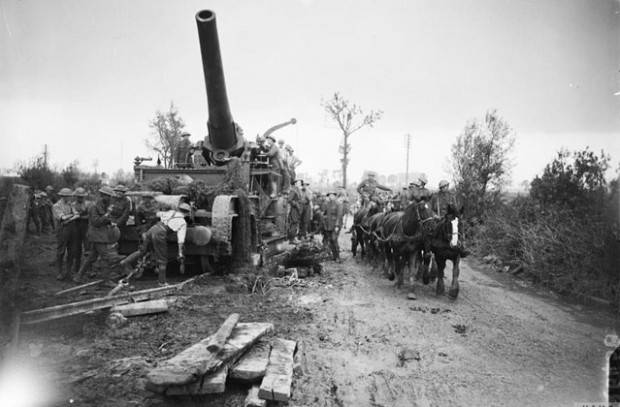
To be continued ...
Information